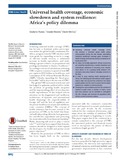Universal Health Coverage, Economic Slowdown and System Resilience: Africa’s Policy Dilemma
| dc.contributor.author | Russo, Giuliano | |
| dc.contributor.author | Bloom, Gerald | |
| dc.contributor.author | McCoy, David | |
| dc.date.accessioned | 2018-05-08T09:44:32Z | |
| dc.date.available | 2018-05-08T09:44:32Z | |
| dc.date.issued | 2017-08-30 | |
| dc.identifier.citation | Russo, G., Bloom, G., McCoy, D. (2017) Universal Health Coverage, Economic Slowdown and System Resilience: Africa’s Policy Dilemma. BMJ Global Health. 2. 3. | en |
| dc.identifier.uri | https://opendocs.ids.ac.uk/opendocs/handle/20.500.12413/13730 | |
| dc.description | Achieving universal health coverage (UHC) has become a dominant global health policy preoccupation during the last decade, advocating ambitious healthcare coverage goals, increases in health funding and financial pooling mechanisms for social protection; As many commodity-dependent African economies are presently experiencing a marked slowdown and international assistance is becoming more volatile, there seems to be a growing divide between UHC principles and policy-makers’ everyday concerns in the field; In order to keep inspiring health development in Africa, UHC thinking and international health support need to take into account the continent’s non-linear growth pattern and the need to ensure that its health systems are resilient to external shocks; Drawing from past mistakes and from the continent’s reaction to past crises, a number of macro, meso and micro policies can be identified to strengthen the UHC concept, and reconcile its aspirations with Africa’s current economic outlook. | en |
| dc.description.abstract | Achieving universal health coverage (UHC) has become a dominant policy reoccupation within the global health community. For Africa, progress towards UHC involves ambitious goals for expanding access to a range of effective health services, a substantial increase in health expenditure, and establishing a greater reliance on prepayment and pooling mechanisms to finance healthcare. This paper argues that if the continent is to remain committed to the concept of UHC, the associated policies and financial tenets need to incorporate the nature of Africa’s non-linear, fragile growth. | |
| dc.language.iso | en | en |
| dc.publisher | BMJ Global Health | en |
| dc.rights | This is an Open Access article distributed in accordance with the terms of the Creative Commons Attribution (CC BY 4.0) license, which permits others to distribute, remix, adapt and build upon this work, for commercial use, provided the original work is properly cited. See: http://creativecommons.org/licenses/by/4.0/ © Article author(s) (or their employer(s) unless otherwise stated in the text of the article) 2017. All rights reserved. No commercial use is permitted unless otherwise expressly granted. | en |
| dc.rights.uri | http://creativecommons.org/licenses/by/4.0/ | en |
| dc.subject | Economic Development | en |
| dc.subject | Health | en |
| dc.title | Universal Health Coverage, Economic Slowdown and System Resilience: Africa’s Policy Dilemma | en |
| dc.type | Article | en |
| dc.rights.holder | The authors | en |
| dc.identifier.externaluri | http://gh.bmj.com/content/2/3/e000400 | en |
| dc.identifier.team | Health and Nutrition | en |
| dc.identifier.doi | http://dx.doi.org/10.1136/bmjgh-2017-000400 | |
| dcterms.dateAccepted | 2017-08-07 | |
| rioxxterms.funder | Default funder | en |
| rioxxterms.identifier.project | Default project | en |
| rioxxterms.version | VoR | en |
| rioxxterms.versionofrecord | http://dx.doi.org/10.1136/bmjgh-2017-000400 | en |
| rioxxterms.funder.project | 9ce4e4dc-26e9-4d78-96e9-15e4dcac0642 | en |
Files in this item
This item appears in the following Collection(s)
Except where otherwise noted, this item's license is described as This is an Open Access article distributed in accordance with the terms of the Creative Commons Attribution (CC BY 4.0) license, which permits others to distribute, remix, adapt and build upon this work, for commercial use, provided the original work is properly cited. See: http://creativecommons.org/licenses/by/4.0/ © Article author(s) (or their employer(s) unless otherwise stated in the text of the article) 2017. All rights reserved. No commercial use is permitted unless otherwise expressly granted.


